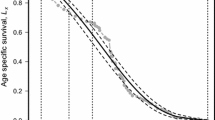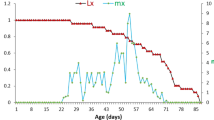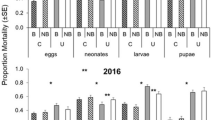Abstract
Data from regular field samples throughout the life cycle for five generations of the legume pod borer, Maruca testulalis on cowpea crops at one site, and three generations at another, were used to construct life tables and through key factor analysis to determine the key mortality factor. The total mortality from egg to adult was 98.4-98.6% at site 1 and 98.2-99.4% at site 2. At both sites the highest mortality occurred between the eggs and the third instar larvae, whilst the fourth instar larvae suffered the lowest mortality. The commonest cause of mortality was classified as disappearance, followed by disease. Parasitism contributed minimally to M. testulalis mortality. At site 1 disappearance at the egg stage was the key mortality factor and was significantly correlated with the total generation mortality. At site 2, disappearance operating at the larva 1 and 2 stage was tentatively identified as the key mortality factor. The data from site 1 showed no significant correlation between population density and mortality at the same stage. This study provides the first detailed analysis of M. testulalis populations and should contribute towards developing control strategies for this important pest of cowpea.
Résumé
Les données receuillies à partie des échantillons réguliers le long du cycle de vie de cinq générations des insectes térébrants de cosses de pois Maruca testulalis, données enregistrées grâce à la récolte faite dans un site, et sur 3 générations dans un autre, étaient utilisées pour établir des tables de longévité et a travers des analyses des facteurs-clés en vue de déterminer le facteur clé de mortalité. Le taux de mortalité entre l’ovulation et l’état adult était de 98.4 à 98.6% au site 1 et 98.2 à 99.4% au site 2. Dans tous les 2 sites la mortalité la plus élevée a eu lieu entre l’ovulation et la 3ème phase à l’état pupal, tandis que la 4ème phase pupale connaissait le taux de mortalité le plus bas. La cause la plus commune de mortalité envisagée était la disparition, suivie par la maladie. Le parasitisme contribuait très peu à la mortalité chez le M. testulalis. Au site 1, la disparition à la phase ovulaire était le facteur clé de mortalité et était étroitement liée à la mortalité globale de la génération. Au site 2, la disparition se passant lors des phases 1 et 2 était identifiée comme la raison principale de la mortalité. Les données obtenues du site n’ont montré aucune corrélation entre la densité de la population et la mortalité au même phase. Cette étude fournit la première analyse détaillée des populations M. testulalis et devrait contribuer au développement des stratégies de contrôle de cette bête qui détruit les cosses de pois.
Similar content being viewed by others
References
Cock M. J. W. (1986) Requirements for biological control: An ecological perspective. Biocontrol News and Information 7, 7–21.
Jackai L. E. N. (1981) Relationship between crop phenology and field infestation by the legume pod borer, Maruca testulalis. Ann. Entomol. Soc. Am. 74, 402–408.
Manly B. F.J. (1974) Estimation of stage specific survival rates and the parameters for insect population development through several stages. Oecologia 15, 277–285.
Morris R. F. (1959) Single factor analysis in population dynamics. Ecology 40, 580–588.
Morris R. F. and Miller C. A. (1954) The development of life-tables for the spruce budworm. Can. J. Zool. 32, 283–301.
Okeyo-Owuor J. B. (1988) Population ecology of the legume pod borer, Maruca testulalis in relation to its natural enemies. Ph.D. Thesis, University of Dar-es-Salaam, pp. 223.
Okeyo-Owuor J. B., Agwaro P. O. and Simbi C. O. J. (1983) Studies on the legume pod borer, Maruca testulalis Geyer — V. Larval population. Insect Sci. Applic. 4, 75–81.
Okeyo-Owuor J. B. and Ochieng R. S. (1981) Studies on the legume pod borer Maruca testulalis Geyer—I. Life cycle and behaviour. Insect Sci. Applic. 1, 263–268.
Richards O. W. and Waloff N. (1954) Studies on the biology and population dynamics of British grasshoppers. Anti-Locust Bull. No. 17, pp. 184.
Solomon M. E. (1964) Analysis of processes involved in the natural control of insects. Adv. Ecol. Res. 2, 1–58.
Southwood T. R. E. (1978) Ecological Methods with Particular Reference to the Study of Insect Populations. Second edition, Chapman and Hall, London, pp. 524.
Taylor T. A. (1967) Bionomics of Maruca testulalis (Geyer) (Lepidoptera: Pyralidae) a major pest of cowpea in Nigeria. J. West Africa Sci. Assoc. 12, 111–129.
Taylor T. A. (1978) Maruca testulalis (Geyer) an important pest of tropical grain legumes. In Pests of Grain Legumes: Ecology and Control (Edited by Singh S. R., Taylor T. A. and van Emden H. T.), pp. 193–200. Academic Press, London.
Varley G. C. and Gradwell G. R. (1960) Key factors in population studies. J. Anim. Ecol. 29, 399–401.
Varley G. C. and Gradwell G. R. (1963) The interpretation of insect population changes. Proc. Ceylon Assoc. Adv. Sci. (D) (1962) 18, 142–156.
Varley G. C., Gradwell G. R. and Hassel M. P. (1973) Insect Population Ecology: An Analytical Approach. Blackwell, Oxford, pp. 212.
Author information
Authors and Affiliations
Rights and permissions
About this article
Cite this article
Okeyo-Owuor, J.B., Oloo, G.W. Life Tables, Key Factor Analysis and Density Relations in Natural Populations of the Legume Pod Borer Maruca Testulalis Geyer (Lepidoptera: Pyralidae) In Western Kenya. Int J Trop Insect Sci 12, 423–431 (1991). https://doi.org/10.1017/S1742758400011310
Received:
Revised:
Published:
Issue Date:
DOI: https://doi.org/10.1017/S1742758400011310




